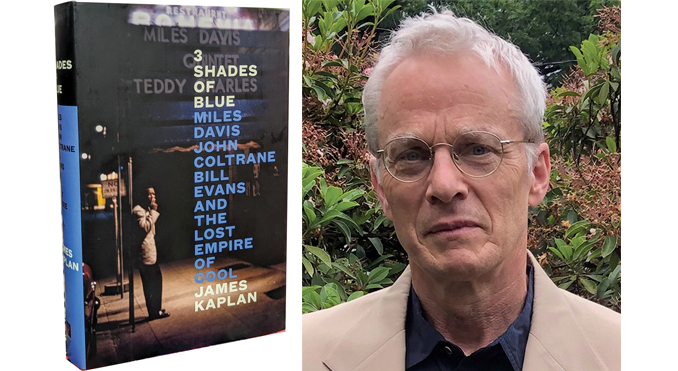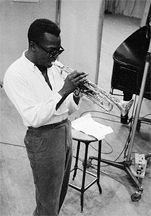
a review by Joe Pipolo
Man, sometimes it takes a long time to sound like yourself. ~Miles Davis

This sentiment is exactly what James Kaplan attempts to trace. Those crazy musical notes like footprints of evolution and definition and self preservation and boundary/genre muscling in the search for the self. A self unattached and unbound to some force outside the self. A self these jazz giants would, or could, accept. In this book, the “long time” of Miles’ quote was, for so many artists, often short and tragic.
If you are a jazz head and looking for a book that centers itself solely on the creation of one of the most iconic jazz albums of all time: Kind of Blue 1959, 3 Shades is not the book. It is about the wild and tragic lives of these three geniuses and all those lives they touched. The book does deal at great lengths with the album, and that attention is exquisite, but the strength of Kaplan’s work is his portrayal of the humanity of these men. The fragile and passionate humanity. The pain of creation. As Walt Whitman talked about in Song of Myself, it is the “urge and urge and urge, always the procreant urge.” It is about being fruitful and fertile. About some palpable expression of who we are or want to be.
The “cool” of this title is complex. It clearly has little to do with the idea being calm and anxiety free. It has little to do with fashionable acceptance. There is of course the allusion to the genre declared “Cool Jazz” which emerged in America in the 1940s. That said, this book has far more to do with the powerful urge of creation to move toward some sort of immortality. And the bitter irony of this is in how many (Kaplan lists them throughout) die in their twenties and thirties trying to do so. Although the three main characters of this book lived longer, their lives remained tortured and mercurial. According to Kaplan, Coltrane and Evans battled depression throughout their lives. In the end, the drugs and alcohol that so often masked insecurities and pain and seemingly drove creativity, took an ugly toll. Miles Davis suffered in most of the same ways. The heroin, the pills, the cocaine and alcohol. The insurmountable depression. However, one notable distinction was the loneliness of Miles’ life and death. Yes, it was a full and busy life. It was crowded and collective. Yet, as Kaplan illustrates from the onset, he was always profoundly immersed in his creative consciousness. Deeply inside. Often, a self-consciousness that isolated him. See the epigraphic quote—Miles was on a steady excavation to sound and feel like himself. Who is to say whether he ever truly did.
But to be clear, there is a deep, deep dig by Kaplan into the complicated and beautiful dedication of these men (and so many others they worked with and were inspired by). It is about the sacrifices and risks. It is about the mutual respect and honesty they shared. Charlie Parker, Cannonball Adderley, Thelonious Monk, Charles Mingus, Dizzy Gillespie, Jimmy Cobb, Clifford Brown, Paul Chambers, Gil Evans, Art Blakey, the Heath brothers… and many others…all of these men are given very careful attention. They all played such an intricate part in each other’s growth, success, failure, destruction and salvation. This is not hyperbole. Read for yourself. I thought I was fairly versed in these artists. I was not. I learned a great deal. Some of what I read I wish I did not. Most of what I learned was remarkable. This book offers powerful insight into the racism, poverty, heroin and alcohol addiction and the maniacal drive of creation. Kaplan’s writing is fluid and entertaining.
 On a local and sunny note, jazz bassist Percy Heath is all over Kaplan’s book. Heath was an important jazz force and serious striped bass fisherman. He was a surfcaster, mostly along the coast of his favorite place to be— his home in Montauk, NY. He spent many years on his fishing boat named, fittingly, “The Fiddler.” Percy, and his jazz performer brothers Jimmy and Albert, were in and out of the same scene that this book unfolds. A memorial plaque for Percy is set into stone at Turtle Cove, Montauk Point. Go up there and read a chapter or two so you can feel the bass fishing bassist. On the dedication plaque it reads, “I’ve been around the world nine times, and I don’t want to be any place else but right here in Montauk.” Pretty cool.
On a local and sunny note, jazz bassist Percy Heath is all over Kaplan’s book. Heath was an important jazz force and serious striped bass fisherman. He was a surfcaster, mostly along the coast of his favorite place to be— his home in Montauk, NY. He spent many years on his fishing boat named, fittingly, “The Fiddler.” Percy, and his jazz performer brothers Jimmy and Albert, were in and out of the same scene that this book unfolds. A memorial plaque for Percy is set into stone at Turtle Cove, Montauk Point. Go up there and read a chapter or two so you can feel the bass fishing bassist. On the dedication plaque it reads, “I’ve been around the world nine times, and I don’t want to be any place else but right here in Montauk.” Pretty cool.
Aside from Kind of Blue 1959, here is what I was listening to as I read 3 Shades. Although this book does not cover some of these years and albums…it was my soundtrack.
Miles Davis: The Corner Sessions 1972 • Turnaround: Rare Miles from the Complete Corner Sessions (New Print 2023) • Sketches of Spain 1960 • Ascenseur pour l’échafaud 1958 • Miles in the Sky 1968
John Coltrane: My Favorite Things 1961 • A Love Supreme: The Complete Masters 1965 • Ole 1961 • Evening at the Village Vanguard with Eric Dolphy (Live) (Release 2023) • Coltrane Live at the Village Vanguard 1962
Bill Evans: Waltz for Debby 1964 • Sunday at the Village Vanguard 1961 • Everybody Digs Bill Evans Trio 1959 • Tony Bennett/ Bill Evans 1975 • Undercurrent 1962

